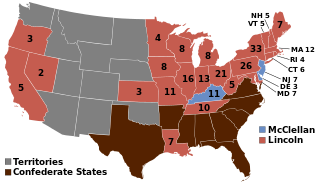Related Research Articles

The Twentieth Amendment to the United States Constitution moved the beginning and ending of the terms of the president and vice president from March 4 to January 20, and of members of Congress from March 4 to January 3. It also has provisions that determine what is to be done when there is no president-elect. The Twentieth Amendment was adopted on January 23, 1933.

The vice president of the United States (VPOTUS) is the second-highest officer in the executive branch of the U.S. federal government, after the president of the United States, and ranks first in the presidential line of succession. The vice president is also an officer in the legislative branch, as the president of the Senate. In this capacity, the vice president is empowered to preside over the United States Senate, but may not vote except to cast a tie-breaking vote. The vice president is indirectly elected together with the president to a four-year term of office by the people of the United States through the Electoral College. Since the passage of the Twenty-fifth Amendment to the US Constitution, the vice president may also be appointed by the president to fill a vacancy, via majority confirmation by both the Senate and the House.

The 1864 United States presidential election was the 20th quadrennial presidential election. It was held on Tuesday, November 8, 1864. Near the end of the American Civil War, incumbent President Abraham Lincoln of the National Union Party easily defeated the Democratic nominee, former General George B. McClellan, by a wide margin of 212–21 in the electoral college, with 55% of the popular vote. For the election, the Republican Party and some Democrats created the National Union Party, especially to attract War Democrats.

The Twenty-second Amendment to the United States Constitution limits the number of times a person can be elected to the office of President of the United States to two terms, and sets additional eligibility conditions for presidents who succeed to the unexpired terms of their predecessors. Congress approved the Twenty-second Amendment on March 21, 1947, and submitted it to the state legislatures for ratification. That process was completed on February 27, 1951, when the requisite 36 of the 48 states had ratified the amendment, and its provisions came into force on that date.

The Twenty-fifth Amendment to the United States Constitution deals with presidential succession and disability.
This section of the timeline of United States history concerns events from 1950 to 1969.

This section of the timeline of United States history concern events from 1900 to 1929.

David Palmer is a fictional character, portrayed by Dennis Haysbert in the television series 24. A U.S. Senator and, later in the series, President of the United States, Palmer serves as the show's second-most prominent protagonist, after Jack Bauer, being forced to make hard decisions as president while also facing opposing elements within his own administration. Throughout the series, Palmer's ex-wife Sherry and brother Wayne are both key figures in his administration. He has two children: a son, Keith, and a daughter, Nicole. Palmer is a member of the Democratic Party. He is in the fourth highest number of episodes of any character in the series behind Tony Almeida (126), Chloe O'Brian (125) and main character Jack Bauer (192), portrayed by Carlos Bernard, Mary Lynn Rajskub and Kiefer Sutherland, respectively.

At 2:15 a.m. Eastern Time on September 20, 1881, Chester A. Arthur was inaugurated the 21st president of the United States. The inauguration marked the commencement of Chester A. Arthur's only term as president. The presidential oath of office was administered by New York Supreme Court Justice John R. Brady at Arthur's private residence in New York City. Two days later, Arthur took part in a second inauguration in Washington, D.C., with the oath administered by Morrison Waite, the Chief Justice of the United States. Arthur became president following the death of his predecessor James A. Garfield, who had been assassinated by a troubled office seeker, Charles J. Guiteau.
In the United States, a contingent election is used to elect the president or vice president if no candidate receives a majority of the whole number of Electors appointed. A presidential contingent election is decided by a special vote of the United States House of Representatives, while a vice-presidential contingent election is decided by a vote of the United States Senate. During a contingent election in the House, each state delegation votes en bloc to choose the president instead of representatives voting individually. Senators, by contrast, cast votes individually for vice president.